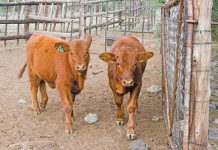Minimum soil disturbance (no-till or direct seeding) is rapidly gaining ground in South Africa as crop farmers attempt to reduce production costs. A recent study by the Kansas State University confirms that more attention needs to be paid to maintaining maximum soil cover, ideally 100% of crop residue and/or a green manure cover crop.
Crop residue is in high demand in some areas of Kansas and other states in the US, either as livestock feed, as feedstock for cellulosic ethanol production, for industrial use or for other uses. Producers can sell their crop residue for these uses, but is it really a good idea to remove and sell this valuable resource? What is the impact of residue removal in terms of loss of soil quality and productivity, and the potential deterioration of surface water quality?
Leaving crop residue on the soil surface is the best and simplest way of reducing water and wind erosion. Widespread residue removal for other uses may accelerate soil erosion and increase the proportion of sediment, nutrients and pesticides in runoff water. Sediment and nutrients draining off agricultural land in runoff water are the main non-point source (NPS) pollutants of downstream water bodies such as ponds, reservoirs, streams and rivers.
But crop residue removal may not be all-or-nothing. The farmer may want to remove some residue and leave some. How much residue can be removed from cropped fields without encountering erosion and runoff problems? The answer is not fully known, and partially depends on the level of crop production. In some cases, particularly in semi-arid regions such as the Great Plains, not enough residue is produced during most years to protect soil from water and wind erosion and maintain adequate levels of soil organic matter. In those cases, any residue removal may further degrade soil quality, increase water pollution and further reduce crop production.
The Kansas State University study
This study assessed on-farm impacts of variable rates of residue removal from wheat and sorghum fields on water erosion in two soils near Hays in 2008. A 20-year no-till field under continuous winter wheat and a 3-year conventional-till grain sorghum field (ploughed in the spring before planting) were selected. The soil in both fields was clay loam, with a slope of 6% for wheat and 3% for sorghum. The stubble remaining after harvest was removed at rates of 0%, 25%, 50%, 75% and 100%. The average height of the standing stubble was 30cm for wheat and 55cm for sorghum. The plots were parallel to the dominant slope. Simulated rainfall applied to the plots gave the effect of a typical once-in-25-years rainstorm in western Kansas. In addition, a second set of plots within each field was established by tilling the soil a few days before rainfall simulation. The concentration of sediment, soil organic carbon and nutrients in the runoff water were measured.
Seeing results
The results showed removing wheat and sorghum residue after harvest exponentially increased sediment, soil organic carbon, and nutrient runoff loss regardless of the tillage system (Figures 1A through 2B). The single high-intensity rainstorm led to large and immediate runoff of sediment and nutrient pollutants on soil where residue had been removed. Where most of the residue was left intact after harvest, the runoff water after the high-intensity rainstorm was clearer. Where half the residue was removed, sediment loss after the rainstorm was higher.
Wheat plots tilled immediately after the residue removal lost more sediment, soil organic carbon and nutrients than no-till wheat plots at the same level of residue removal. This suggests residue removal in combination with intensive tillage can accelerate soil erosion to unsustainable levels. Differences in soil slope influences the amount of pollutants in runoff water. More runoff, sediment, soil organic carbon and nutrients were lost from the freshly tilled wheat plots with a 6% slope than from the sorghum-tilled field with a 3% soil slope .
Removing more than 75% of the residue after harvest can negate many of no-till’s benefits in reducing runoff. At this level of residue removal, the loss of NPS pollutants from no-till soil was equal to that from ploughed soil . This indicates, when a high proportion of residue is removed, no-till may be no better than ploughing.
Removing a excessive amount of residue from no-till soil can also negate the erosion control benefits attributed to no-till. Soil erosion control benefits of no-till are quickly lost when more than 25% of the residue is removed, as residue cover is needed to keep the soil in place.
Removing residue after harvest has a further negative effect on the soil carbon level, even in no-till wheat systems (Figure 2A). The large losses of soil organic carbon with residue removal at levels as low as 50%, indicate a single high intensity rainstorm could eliminate all the gains in the organic carbon content of soil attributed to no-till.
The large losses of soil organic carbon in sediment may have serious soil, agronomic, and environmental implications. Organic carbon is essential to the soil’s ability to absorb and filter NPS pollutants and improve soil productivity.
Residue removal also increased losses of essential nutrients, particularly total nitrogen (Figure 2B) and total phosphorus. Loss of nutrients in runoff increased when 50% or more of the residue was removed in no-till wheat. Residue removal reduces nutrient pools through two pathways – via residue and via increased runoff.
This study showed crop residue was essential to reduce sediment, soil organic carbon, and nutrient loss in runoff water, irrespective of the tillage system.
Removing crop residue is not recommended when soil and water conservation, NPS pollution control, and soil carbon buildup are priorities. Residue left on the soil surface protects the soil from impacting raindrops, helps maintain the integrity of soil aggregates, and improves rain water infiltration.
A small fraction of about 25% residue may be available for removal from no-till soils, but further studies monitoring pollutant losses under different rainfall intensity and soil/topographic characteristics scenarios are needed to determine the amount of harvestable residue. Contact Humberto Blanco from the Agricultural Research Centre Hays, Kansas State University at [email protected]. |fw








